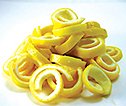Even ugly people look refined when they're holding martinis with bright yellow twists on their rims. While Champagne is a must for your New Year's toast, most people don't want to drink bubbly all night, lest they succumb to an embarrassing fit of hiccupping or the dreaded Champagne migraine. Martinis, by contrast, convey all the elegance and good cheer of the holidays at a fraction of the cost. Furthermore, nothing beats back a horde of thirsty revelers like a round of ice-cold martinis.
You should have olives on hand for those who prefer them, but many martini drinkers would rather have a lemon twist. For martinis such as a cosmopolitan, nothing but a twist will do, and those pink martinis with a bright yellow twist on the rim are sure to bring a sparkle to any celebrant's eyes. Yet who wants to spend hours carving away at lemons only to produce a handful of limp, mangled twists?
Before I took up the rakish life of an editor, I spent several years bartending at a 4-star French bistro in Milwaukee, Wis. The holidays were always our busiest time of the year, and we served hundreds of bottles of Burgundy and Bordeaux, Cotes du Rhone and Muscat. We also served an ungodly number of martinis and literally hundreds of twists a night. Here is the insider's guide to making a whole lot of twists.
To make enough twists for 50 martinis, you will need at least 12 lemons. Generally, one lemon will make four or five twists.
Begin by soaking the lemons in warm water for 15 minutes. This makes it much easier to separate the fruit from the rind. Furthermore, the rind itself will become much more pliable and less likely to tear.
Once your lemons have soaked, select your first victim and cut off either end. You should now have what looks like a yellow barrel. Next, cut a thin wedge out of the lemon along its length. The size of the wedge doesn't matter, so long as it's large enough to give you access to the lemon's innards.
Now, here comes the only tricky part. Take an ordinary spoon and slide it between the rind and the fruit along the seam where the wedge was removed. The object here is to get the fruit to separate cleanly from the rind. There's actually a thin membrane on the outside of the fruit, so if you're doing this right, the fruit should come out cleanly, with no shredding. Continue working the spoon around the lemon until all of the fruit is out, leaving you with nothing but the rind. Repeat until all of your lemons have been cleaned.
Now for the fun. Once your lemons are clean, roll one up like a carpet, and then run it through with the skewer. You can leave it on the skewer for mere minutes or for hours covered in the fridge. Before the party begins, remove one of your rolled-up lemons and cut off your first twist. In no time, you will convert your rolled-up lemon into four or five beautiful lemon twists. They will hold their corkscrew shape from being rolled up on the skewer, which means they will cling to the edge of a martini glass. Just give a twist to your twist in order to release the essential oils, and then smear it around the rim of the martini glass. Many people mistakenly smear the white part rather than the yellow around the glass because it is juicier, but what we want are the oils from the rind itself.
Follow these insructions and your guests will throw down their Champagne flutes to clamor for martinis. You will look like one sophisticated host.


